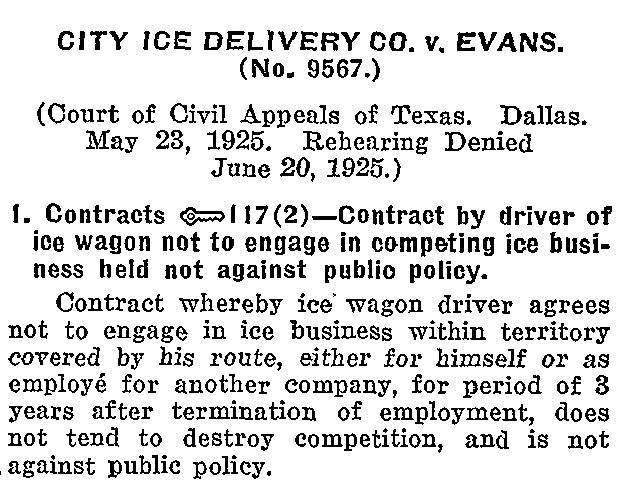Do Ancient Cases Hold the Secrets to Understanding Present-Day Texas Non-Compete Law?
“Non-compete abuse” is a hot topic. The press says some employers now require even rank-and-file employees to sign non-competes. The Jimmy Johns case was perhaps the low point. You’re going to make sandwich makers sign non-competes. Really? Are they going to run off with the secret bread-slicing techniques? Misappropriate goodwill from Jimmy Johns and take it to Quiznos?
Here’s another case I recently read about that just goes too far. The Patterson Institute, a small music school in Hillsboro, Texas, hired young Bill Crabb to teach piano, organ, violin, mandolin, and banjo, as well as music theory, harmony, and history. Crabb signed a 10-month employment contract, which included a non-compete barring him from teaching music in Hillsboro if he quit the job.
Then tension developed between Crabb and the Institute’s senior music teacher, Mary Rice. Crabb quit and opened a small music school of his own in Hillsboro. The Patterson Institute filed suit and obtained a temporary injunction, but the trial court dissolved the injunction after a trial.
The Court of Appeals reversed, holding that the statute prohibiting restraints of trade did not apply. The court reasoned that it would be inequitable for Crabb to teach at an independent school in Hillsboro, that the statute did not bar the restrictive covenant, and that the Institute was entitled to an injunction. The court cited Gates v. Hooper, in which the Texas Supreme Court held that a non-compete in the sale of a business was not an illegal restraint of trade.
But enforcing a non-compete against a small-town music teacher? This is just too much. The Texas legislature should do something about this kind of non-compete abuse.
Unfortunately, it’s too late for Mr. Crabb. You see, his case was decided in 1899. See Patterson v. Crabb, 51 S.W. 870, 871-72 (Tex. Civ. App. 1899).
But his case is a good reminder that non-competes have been around for a long time. By comparison, the Texas non-compete statute is relatively young. It just celebrated its 30th birthday in September.
I’ll confess that, even as a lawyer who has read a lot of Texas non-compete cases, I usually don’t pay attention to case law that predates the 1989 statute. But the statute was largely intended to codify Texas common law on non-competes (or at least parts of it). So, many of the issues found in older cases are still relevant.
Here’s a chronological sampling of some principles in older Texas non-compete cases that still apply today.
1. Texas courts generally favor non-competes in the sale of a business.
Gates v. Hooper, 39 S.W. 1079, 1080 (Tex. 1897), was the case cited in Patterson v. Crabb. It’s the oldest Texas non-compete case I have found so far. (If you find an older one please email me.) You can tell it’s an old case because the opinion is short but the paragraphs long.
This was the Gilded Age when monopolistic “trusts” were a major concern. But the court in Gates upheld a one-year non-compete in a contract for the sale of a mercantile business in Batesville. The court held that the non-compete was not a prohibited “trust” or “combination” because the transaction did not combine the capital, skill, or acts of the parties into any kind of “union, association, or co-operative action.” Id. at 1080-81.
That was it. Nothing about reasonableness. But it set a precedent favoring non-competes in the sale of a business.
2. Non-competes are uniquely and primarily about protecting goodwill.
The two most common justifications for non-competes are (1) protecting a company’s goodwill and (2) protecting a company’s confidential information.
Reading between the lines, we can imagine both issues were present in Patterson v. Crabb. The opinion is pretty thin on reasoning, but we can assume the Patterson Institute established goodwill with its customers, i.e. its students. We can also assume that Mr. Crabb knew the students, knew the tuition they were paying, and could use that knowledge to set his own school’s tuition just low enough to “undercut” the Institute.
But there’s a fundamental difference between these two interests. There are multiple areas of law that protect an employer’s confidential information. See The Matrix: Making Sense of the Patchwork of Employee Confidentiality Duties.
In contrast, there is really only one legal mechanism to protect goodwill: a non-compete.
And a non-compete always has two fundamental problems. First, it hurts customers. If Mr. Crabb can’t teach music in Hillsboro, the students in Hillsboro may have only one place to go. Second, a non-compete can prevent someone from making a living doing the thing they do best. It doesn’t seem right to force Mr. Crabb to either move out of Hillsboro or change careers.
3. Non-competes should not restrain the right to earn a living.
These problems are not new. Over a hundred years ago, in Miller v. Chicago Portrait Co., 195 S.W. 619 (Tex. Civ. App.—San Antonio 1917, writ ref’d), Mr. Miller signed an employment contract with Chicago Portrait Company, which was in the business of enlarging photographs into portraits. The contract contained a one-year non-compete. Id. at 619.
The Court of Appeals reversed an injunction issued by the trial court. As to confidentiality, the court noted there was “no evidence of trade secrets connected with inducing people to have their photographs magnified into portraits and placed in expensive frames.” Id. at 620.
As to goodwill, the court distinguished between a contract for the purchase of a business and an employment contract, citing an employee’s interest in earning a living:
Courts will not favor contracts that would drive a man out of Texas to seek occupation in a business, with which he is perhaps better acquainted than any other, or put him in another business for which he is not trained or suited. This is a different case from the sale of a business induced by a contract not to engage in a similar business in a named locality in a specified time. The contract in this case is aimed at the right to obtain employment in a similar business. It is an attempt to restrain the right to earn a living.
Id. at 621.
So yes, there is a legitimate interest in protecting goodwill, but that interest must be weighed against an employee’s right to earn a living (and to stay in Texas), especially where no real trade secrets are involved.
Today, the Texas non-compete statute does not expressly refer to the employee’s interest in making a living, but that interest is embedded in the statute’s key concept: reasonableness.
4. Reasonableness is the key to non-compete law.
Given the competing interests at stake in any non-compete dispute, the fuzzy standard of “reasonableness” is critical.
The idea of measuring the enforceability of a non-compete by its reasonableness made an early appearance in Texas law in Randolph v. Graham, 254 S.W. 402 (Tex. App.—San Antonio 1923, writ ref’d). In that case, Dr. Randolph sold his medical practice to Dr. Graham, who agreed not to practice medicine within a 20-mile radius of Schertz, Texas. Id. at 402.
The Court of Appeals affirmed the trial court’s temporary restraining order enforcing the non-compete. The court first cited the policy in favor of enforcing non-competes tied to the sale of a business, reasoning that “professional men” or “skilled artisans” ought to be able to sell the goodwill of their businesses, and invoking “liberty and freedom of contract.” Id. at 402-3.
But the court implicitly recognized the limits of freedom to contract by then addressing the reasonableness of the restriction. The court cited cases from other jurisdictions holding that a contract in restraint of trade is unreasonable and void when it is unlimited in time and space. While the non-compete at issue was unlimited in time, it was limited to the Schertz area, and the court found that limitation sufficient to make the non-compete reasonable and enforceable. Id. at 403-4.
This would not be the last time that parties argued about whether the scope of a Texas non-compete was reasonable.
5. Reasonableness means a non-compete injunction should do no more than necessary to protect the goodwill the employee developed for the company.
By 1925, the essential elements of early Texas non-compete law came into focus, as illustrated by City Ice Delivery Co. v. Evans, 275 S.W. 87 (Tex. Civ. App.—Dallas 1925, no writ).
That case involved an employment contract between a driver and an ice delivery business in Dallas. The business divided its territory into districts, assigning each district to an employee. The contract prohibited the driver, Mr. Evans, from engaging in the ice business within the territory covered by his route, or within five squares of his route. Id. at 88-89.
By this time, the court said it was the “settled law” of Texas that a contract for the sale of a business may include a non-compete reasonably necessary to protect the purchaser’s interest in the goodwill of the business. Id. at 89.
But did the same principle apply to an employment contract? Looking to authorities outside Texas, the court found that non-competes in employment contracts should be governed by the same principles:
The test generally applied to determine the validity of such a covenant in a contract of employment depends upon whether or not restraint placed upon the employé after employment has ceased is necessary for the protection of the business or good will of the employer, and whether it imposes on the employé any greater restraint than is reasonably necessary to secure protection to the business of the employer or the good will thereof. If the covenant in question goes no farther than to accomplish this purpose, it is generally held to be valid.
Id. at 90. (NB: An “employé” is an employee who speaks French.)
In short, like a non-compete in the sale of a business, a non-compete in an employment contract is governed by the related principles of reasonableness and necessity to protect goodwill.
Thus, the court said, the burden is on the employer to establish both the “necessity for” and the “reasonableness of” the non-compete. Applying this principle to the employer’s claim for an injunction, the court said that the evidence clearly established the necessity of the non-compete as to the immediate territory where Evans delivered ice to the company’s customers. Id.
But there was no such necessity for the five squares outside of his territory, the court reasoned, because the company had no goodwill outside of the employee’s territory that was due to the employee’s “personal contact” with the trade while in service of the employer. Id.
This critical principle is sometimes ignored but still applies today. An injunction should extend no further than necessary to protect the goodwill that the employee developed on behalf of the employer.
Seven years later, the Dallas Court of Appeals would cite City Ice Delivery and other cases and distill the essential requirements of Texas non-compete law as follows:
(1) Is the restraint placed upon the employee, after the employment had ceased, necessary for the protection of the business or good will of the employer?
(2) Does it impose upon the employee any greater restraint than is reasonably necessary to procure protection to the business of the employer or the good will thereof.
Martin v. Hawley, 50 S.W.2d 1105, 1108 (Tex. App.—Dallas 1932, no writ).
This language is strikingly similar to the language the legislature would use over 50 years later in the 1989 non-compete statute. The court also cited the general principle that “contracts restricting the liberty of employment are not viewed by the courts with favor.” Id. at 1108.
Thus, even back in 1932, we can clearly see the two competing considerations: protect the employer’s goodwill to the extent necessary, but without unduly restricting employee mobility. The dividing line is what is reasonably necessary to protect the employer’s goodwill.
6. Generally Texas courts will enforce an unreasonable non-compete to a reasonable extent.
While the basic reasonableness concept took shape in Texas cases as early as the 1930s, it was not entirely clear what a Texas court was to do if a non-compete was unreasonably broad.
This issue was implicit in City Ice Delivery, where the court enforced the non-compete only in part, to the extent of prohibiting competition in the driver’s immediate territory. Later the Texas Supreme Court addressed the issue more directly in Lewis v. Krueger, Hutchinson & Overton Clinic, 269 S.W.2d 798 (Tex. 1954).
In that case, young Dr. Lewis signed an employment contract with a clinic that barred him from practicing medicine in Lubbock County if his employment ceased. The trial court found the non-compete entirely unenforceable because it had no time limitation. The Court of Appeals disagreed but reduced the limitation to three years. Id. at 798-99.
Dr. Lewis argued the court could not make a new and different contract for the parties, but the Texas Supreme Court rejected this argument. Even though the non-compete could be interpreted as applying for life, “it would hardly be doing violence to the established principles to hold that the restriction is merely void or unenforceable with respect to that portion of the time beyond what the court considers reasonable.” Id. at 799-800.
This “blue pencil” rule allows the court to effectively rewrite the non-compete, and it still applies today. Enforcement of a non-compete is not all or nothing in Texas. Generally, if the non-compete is unreasonably broad, it can still be enforced, but only to a reasonable extent.
7. You can’t get damages for breach of an unreasonably broad non-compete.
But what about damages? Can the employer get damages for the employee’s breach of a non-compete that’s unenforceable as written?
The Texas Supreme Court addressed this issue in Weatherford Oil Tool Co. v. Campbell, 340 S.W.2d 950 (Tex. 1960). Citing Martin v. Hawley, the court said the non-compete as written was unreasonable because it had no territorial limitation. Then, citing Lewis, the court said an injunction could still be granted to restrain the employee from competing within a reasonable area. Id. at 952.
But the court said a claim for damages was not available prior to reformation. “We hold that an action for damages resulting from competition occurring before a reasonable territory and period have been prescribed by a court of competent jurisdiction must stand or fall on the contract as written.” Id. at 953. In other words, if the employer drafts a non-compete that is too broad, the employer can still seek an injunction, but it can’t get damages that occur before the court narrows the scope of the non-compete.
The Texas Supreme Court later clarified that the court’s power to reform the non-compete applies to both time and area. Justin Belt Co. v. Yost, 502 S.W.2d 681, 685 (Tex. 1974).
The Weatherford rule concerning damages was later codified in the 1989 statute. Five years later, Jimmy John’s started franchising. And the rest is history.
________________________

These are his opinions, not the opinions of his firm or clients, so don’t cite part of this post against him in an actual case. Every case is different, so don’t rely on this post as legal advice for your case.






Comments:
That this is an excellent analysis of some important elements of non-compete covenants is obvious. However, what particularly strikes me is how Zach shows that a historical view of those elements, their evolution over time, is a much better way to understand those elements than merely reading the most recent cases that deal with them.
Thanks, Stanley. It was fun reading these older cases.
That this is an excellent analysis of some important elements of non-compete covenants is obvious. However, what particularly strikes me is how Zach shows that a historical view of those elements, their evolution over time, is a much better way to understand those elements than merely reading the most recent cases that deal with them.